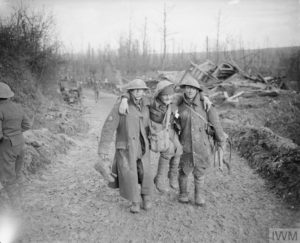Thursday July 18th, 1918
4th day defaulters, Reveille 6:30. Orderly man off parade and in cook house. Rained hard again. Aircraft over camp in morning. Mail from Salonika, one from home, one from South Africa and one from our Sam.
Crucifixion?
There were some rumblings about the administration of Field Punishment No 1 in the summer of 1916. Nicknamed ‘crucifixion’ by the troops, a question was asked about it in Parliament as early as in June. In August, the case of Driver Graham of the 30th Division who was sentenced to 90 days Field Punishment No 1 for driving too fast was widely reported. This resulted in public outrage and Driver Graham’s sentence was quashed.
Such public sentiment, in support of its civilian army, is easy to understand. ‘What can we do to show effective practical sympathy for the men who are daily facing death for us in the field? It is a question we at home often ask ourselves with disparity for our ineffectiveness. There is one thing we can do. We can as a public insist that they shall be immune from degrading punishment for trivial offences.’¹
The Situation Hots Up
At the end of October 1916, the socialist and reformer Robert Blatchford wrote an article in the Illustrated Sunday Herald about field punishment. In it, he quoted from a letter he had received about six soldiers from Liverpool who had been subjected to ‘crucifixion’ for losing their gas masks. One man apparently died. ²
This led to questions being raised in the House of Commons. Interestingly, while many MPs were pushing for the end of Field Punishment No 1, at least one MP suggested that the Illustrated Sunday Herald should be prosecuted if the allegations proved untrue.³
Public Reaction

Various societies, trade unions and others protested more formally, sending resolutions to the government and War Office. Under the heading, The Crucifixion Punishment, one such was reported in the Guardian.
‘The following resolution has been passed by the Committee of the Humanitarian League and sent to the Secretary of State for War:- ‘That this Committee expresses its earnest hope that the Secretary of State for War will put an end to Field Punishment No 1, commonly known as Crucifixion, a practice which is a disgrace not only to those who ar subjected to it but to the army and the nation. It being admitted that discipline has much improved since the abolition of flogging, there is every reason to desire that this kindred brutality should follow the cat-o-nine-tails into disuse.’º
In Parliament, Mr Macpherson, Under-Secretary for War, defended the status quo. He said that the GOC of the armies wouldn’t want to be without it and its removal could lead to more death penalties. He claimed that Field Punishment No 1 was essential to the rapid build up and discipline of new army units. ’He was sure the House would recognize that civilian standards of what was a suitable form of punishment were quire inapplicable to the necessarily sterner conditions of active service.’†
After five months of the Battle of the Somme (photograph), the public, as we will see, remained unimpressed.
13th (Service) Battalion War Diary – 18th July 1918 – Abancourt, France
Training as in programme.
References & Further Reading
¹ ‘Field Punishments’ The Guardian, August 9th, 1916
² ‘Field Punishment No 1′ by John Simkin on Spartacus
³ The Guardian, November 8th, 1916, page 6
º Article in The Guardian, December 16th, 1916, page 5
† The Guardian, December 20th, 1916, page 9
* Q 4538, copyright Imperial War Museums. Image – Battle of the Ancre. Bringing in an uninjured man. Hamel, November 1916.


